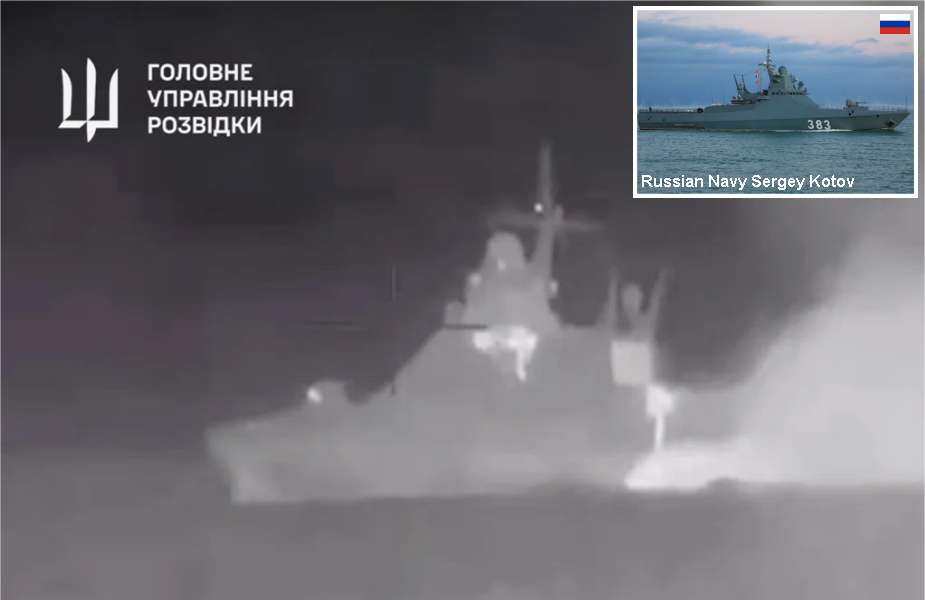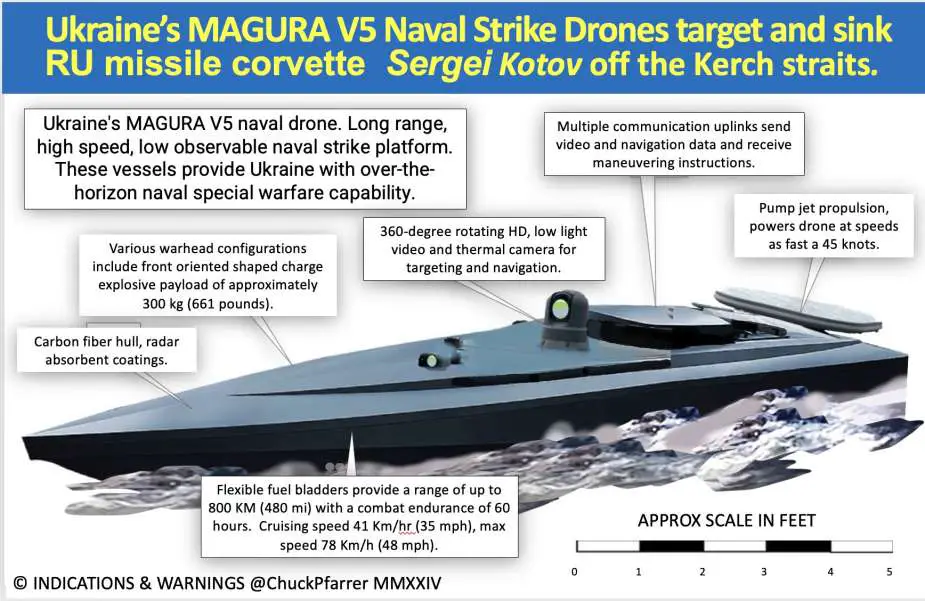Breaking news
British Intel: Russia Bolsters Naval Defenses in Response to Successful Ukrainian Naval Drone Attacks.
In reaction to Ukraine's effective maritime strikes, Russian Defence Minister Sergey Shoigu made a strategic visit to the Black Sea Fleet's headquarters in Crimea on March 17, 2024. This visit underscores Russia's efforts to reinforce its naval defenses against ongoing Ukrainian attacks using UAVs (Unmanned Aerial Vehicles) and USVs (Unmanned Surface Vessels), challenging its control over the Black Sea. This development was detailed in a report by the British Ministry of Defense Intelligence Services on March 19, 2024, highlighting the significant impact of Ukrainian tactics on Russian naval operations. (Graphics of Magura V5 from Chuck Pfarrer X account)
Follow Army Recognition on Google News at this link

A video released by Ukraine's Defense Intelligence reveals the moment a Russian Sergei Kotov patrol ship was targeted in the Black Sea. (Picture source Ukraine MoD)
During his visit, Minister Shoigu was briefed on the latest Ukrainian operations and reviewed the current performance of Russian naval assets in the strategic region. In response to the escalating threat, the Russian Ministry of Defence announced the implementation of new defensive measures designed to enhance the BSF's capability to counter UAV (Unmanned Aerial Vehicle) and USV (Unmanned Surface Vessel) threats.
A key component of these measures includes the initiation of daily anti-UAV/USV preparedness exercises. These drills aim to ensure that the ships' crews can swiftly counter attacks at any time, enhancing their readiness to deal with UAV and USV incursions both during the day and at night. Furthermore, Minister Shoigu has mandated the fitting of additional large-caliber weaponry on select naval assets, significantly boosting their defensive capabilities against maritime threats.
The effectiveness of Ukraine's maritime strike strategy has forced the Russian Navy to reassess its operational posture in the Black Sea. With mounting losses and increasing threat perceptions, the Russian naval forces are now highly likely to confine their operations to the eastern part of the Black Sea. This strategic shift is indicative of Russia's growing concerns over the durability of its Black Sea Fleet in the face of persistent Ukrainian assaults.
The onset of hostilities in the Black Sea transpired on the verge of a comprehensive invasion, with Vladimir Putin directing his naval forces to enforce a blockade on Ukraine's Black Sea ports well over a week prior to Russian armored units crossing the border on February 24, 2022. On the surface, the maritime conflict seemed decidedly one-sided, with Ukraine's modest navy, comprised of a few small ships, vastly inferior to the formidable Russian Black Sea Fleet. Nonetheless, it wasn't long before Ukraine began to defy these expectations.
Ukraine marked its initial maritime victory in April 2022 by sinking the Moskva, the flagship of the Russian Black Sea Fleet, with a pair of Neptune anti-ship missiles. By June 2022, Ukraine had managed to retake Snake Island, a diminutive but tactically vital island in the Black Sea, which Russia had seized on the invasion's first day. Towards the end of summer 2022, Ukraine initiated drone attacks against the Russian fleet and naval bases in the Crimea region, under Russian control.
The year 2023 saw these operations intensify significantly, driven by enhancements in Ukraine's naval drone capabilities and the integration of British and French cruise missiles into its armory. Noteworthy successes included a distant marine drone assault on a Russian warship near Novorossiysk in the eastern Black Sea, and the annihilation of a Russian submarine and a warship under maintenance at Sevastopol in Crimea, the historical base of the Russian Black Sea Fleet.
On March 5, 2024, Ukrainian forces successfully targeted a Russian patrol ship, Sergei Kotov, with maritime drones from their Group 13 special unit in the Black Sea, close to the Kerch Strait. This operation is part of a series of attacks that Ukraine claims have significantly depleted the Russian Black Sea Fleet's strength since the war began.

The Magura V5 is an advanced Ukrainian unmanned surface vessel designed for maritime operations, equipped with GPS, cameras, and a low radar signature, capable of carrying explosives and transmitting live video. (Picture source Twitter Chuck Pfarrer)
In early March 2024, a Ukrainian Magura sea drone strike targeted and sank a Russian warship in the Black Sea, marking the continuation of a series of successful assaults against Moscow's naval forces as the conflict enters its third year. These attacks, including the recent engagement of the Sergei Kotov patrol ship near the Kerch Strait, have significantly hampered Russia's naval operations and bolstered morale in Kyiv, supporting its forces along an extensive front line despite being outnumbered and outgunned.
Ukraine's strategic deployment of unmanned drone boats, notably the advanced Magura V5, has shifted naval warfare dynamics in its favor against Russia. These drones, equipped with cutting-edge navigation and stealth capabilities, are nearly undetectable and capable of delivering explosive payloads over long distances while providing real-time video feedback to their operators. This innovation has played a pivotal role in challenging Russia's naval superiority.
The Magura V5, an advanced naval drone designed and manufactured by Ukrainians, it measures 5.5 meters in length and weighs up to 1,000 kilograms. With a significant range of 800 kilometers and a 60-hour battery life, this drone can carry a payload of up to 200 kilograms. Additionally, it is capable of transmitting live video back to its operators.
As Ukraine continues to exploit opportunities for long-distance strikes against Russian naval forces, the increased defensive measures announced by Minister Shoigu underscore the Russian Ministry of Defence's commitment to preserving its naval strength in the Black Sea. This development marks a significant moment in the ongoing conflict, highlighting the changing dynamics of naval warfare in the region.
Defense News March 2024



















